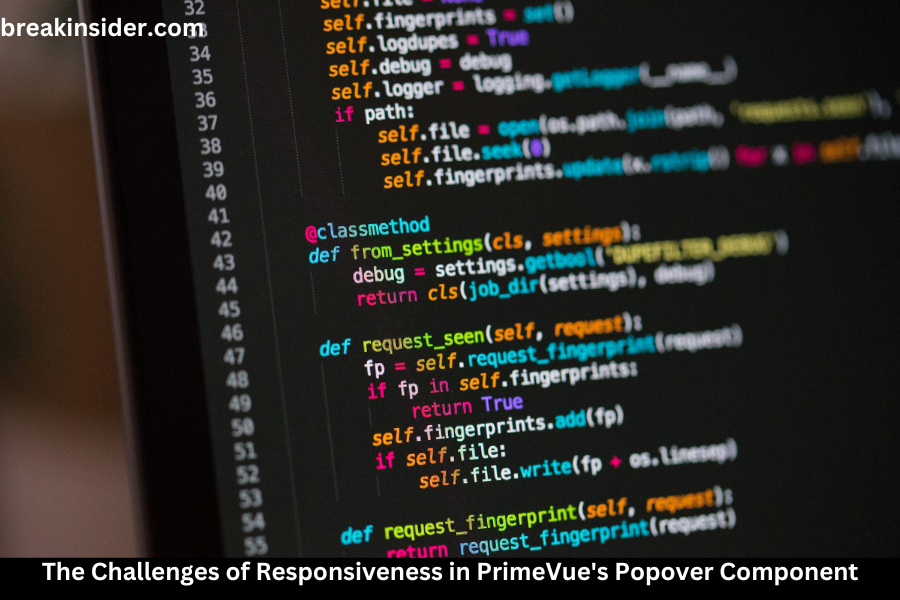
Unleashing the Power of Popovers: A Deep Dive into PrimeVue in 2024
Alex
- 0
Table of Contents
ToggleUnderstanding Why the Popover Component Does Not Exist in PrimeVueUnleashing the 8
In the fast-paced world of web user interface frameworks play a pivotal role in shaping the way we build applications. After A Deep Dive into PrimeVue, Popover stands out as a powerful library offering a rich set of UI components specifically designed for Vue.js applications. However, one notable absence in PrimeVue is the popover component—a feature commonly found in other libraries that provides contextual information in a compact, interactive format.
This article aims to explore the reasons behind the absence of a popover component in PrimeVue, the implications for developers, and how to create a popover-like functionality using existing PrimeVue components. We will also delve into the broader context of user interface design, the importance of contextual information, and practical examples that can help developers effectively implement this feature in their projects.
The Importance of Popovers in Web Development
Before we explore PrimeVue’s limitations, it’s essential to understand the fundamental role that popovers play in modern web applications. Popovers are small overlay elements that provide additional information or options when a user interacts with a UI element, typically through clicks or hovers. They are used for various purposes:
- Enhanced User Experience: Popovers allow users to access contextual information without leaving the current view, which keeps users engaged and informed. This is particularly valuable in complex applications where navigation can become cumbersome.
- Space Efficiency: By displaying information on demand, popovers help maintain a clean and uncluttered interface. Instead of overwhelming users with excessive content, developers can provide relevant information only when necessary.
- Interactivity: Popovers can include various UI elements, such as buttons, forms, or links, making them versatile for different applications. This interactivity encourages user engagement and can lead to improved conversion rates in applications that require user input.
Given these advantages, the absence of a built-in popover component in PrimeVue raises questions for developers who wish to implement similar functionalities. Let’s explore the design philosophy of PrimeVue and the implications of not having a dedicated popover component.
The State of PrimeVue Components
PrimeVue boasts a rich ecosystem of components designed to enhance the development process. From data tables to charts, the framework offers tools that cater to diverse needs. However, the lack of a dedicated popover component may indicate a design philosophy that prioritizes simplicity and minimalism. This approach allows developers to focus on essential functionalities without overwhelming them with too many options.
Moreover, PrimeVue’s component architecture encourages modular design. Each component serves a specific purpose, which can lead to a cleaner codebase. By not including a popover component, PrimeVue may be nudging developers to think critically about how they present information in their applications. Instead of relying on a pre-built solution, developers can create tailored experiences that fit their application’s specific requirements.
Reasons for the Absence of a Popover Component
Several reasons might explain why PrimeVue does not include a popover component:
- Design Philosophy: As mentioned earlier, PrimeVue’s commitment to a clean and straightforward design philosophy may lead to the omission of certain components. By focusing on core functionalities, the library remains lightweight and easier to maintain.
- Alternative Solutions: The PrimeVue team may believe that existing components can achieve similar effects. For instance, tooltips and dialogs can provide contextual information, albeit in different formats. This strategy encourages developers to use the available tools creatively.
- Encouragement of Customization: The absence of a popover component may encourage developers to create customized solutions that better fit their specific needs. This flexibility can lead to innovative implementations that align more closely with the unique requirements of individual projects.
- Performance Considerations: Having too many components can bloat a library and lead to performance issues. By keeping the number of components manageable, PrimeVue can maintain better performance and usability.
Creating Popover Functionality in PrimeVue
Although PrimeVue does not offer a dedicated popover component, developers can still implement similar functionality by creatively using existing components and custom styling. Here’s a comprehensive guide to creating a popover-like experience in PrimeVue.
Step 1: Choosing the Right Components
To simulate a popover, we can utilize several PrimeVue components, notably:
- OverlayPanel: This component can be used to display additional content on top of existing elements.
- Tooltip: A tooltip can serve as a simple alternative for providing brief information.
- Dialog: For more complex interactions, a dialog can be employed, though it requires a more substantial commitment from the user.
Step 2: Implementing the OverlayPanel
The OverlayPanel is the closest alternative to a popover in PrimeVue. Here’s a detailed example of how to implement it:
htmlCopy code<template>
<div>
<Button label="Show Info" @click="showOverlay" />
<OverlayPanel v-model:visible="overlayVisible" :dismissable="true" :showCloseIcon="true" :style="{ width: '200px' }">
<h3>Popover Title</h3>
<p>This is the content of the popover. You can add more details here!</p>
</OverlayPanel>
</div>
</template>
<script>
import { ref } from 'vue';
import { Button } from 'primevue/button';
import { OverlayPanel } from 'primevue/overlaypanel';
export default {
components: {
Button,
OverlayPanel,
},
setup() {
const overlayVisible = ref(false);
const showOverlay = (event) => {
overlayVisible.value = true;
event.stopPropagation();
};
return { overlayVisible, showOverlay };
},
};
</script>
In this example, clicking the “Show Info” button triggers the OverlayPanel to appear, effectively simulating a popover. The :dismissable prop allows users to click outside the overlay to close it, adding to the usability of the component.
Step 3: Custom Styling for Enhanced Appearance
To enhance the look and feel of the OverlayPanel, you can apply custom CSS styles. This can help mimic the behavior and design of traditional popovers found in other frameworks.
cssCopy code.overlaypanel {
background-color: #fff;
border: 1px solid #ccc;
border-radius: 5px;
box-shadow: 0 2px 10px rgba(0, 0, 0, 0.1);
padding: 10px;
}
Adding this custom CSS will give your OverlayPanel a more polished appearance, making it feel more like a traditional popover.
Best Practices for Using OverlayPanel as a Popover
When implementing an OverlayPanel to serve as a popover, consider the following best practices:
- Accessibility: Ensure that your implementation is accessible. This includes proper focus management and keyboard navigation. Make sure that screen readers can identify and describe the content inside the OverlayPanel.
- Responsiveness: Test the OverlayPanel on various screen sizes to ensure it remains usable and visually appealing. Using relative units for dimensions and layout can improve responsiveness.
- User Interaction: Consider how users will interact with the OverlayPanel. Implement dismiss behaviors for clicks outside of the panel or via keyboard shortcuts. This enhances the user experience by providing intuitive ways to close the overlay.
- Performance: Since OverlayPanels can be created dynamically, be mindful of performance. Avoid rendering too many panels simultaneously, which can lead to a sluggish user experience.
Use Cases for Popover Functionality
To further illustrate the usefulness of popover-like functionality, here are several practical use cases where this feature can enhance user experience:
- Tooltips for Form Fields: Use popovers to provide additional information or examples for form inputs, enhancing user comprehension. This is particularly useful for fields that may require specific formats or values.htmlCopy code
<template> <div> <InputText placeholder="Enter your email" v-model="email" /> <Button label="Help" @click="showHelp" /> <OverlayPanel v-model:visible="helpVisible" :dismissable="true"> <p>Please enter a valid email address (e.g., user@example.com).</p> </OverlayPanel> </div> </template> - Additional Information for UI Elements: When hovering over buttons or icons, popovers can display related actions or descriptions. This can be particularly useful in dashboards or control panels where users may need quick guidance on functionality.
- Contextual Help: Implement popovers to guide users through complex processes or to offer tips based on their actions. For example, a project management tool could use popovers to explain the purpose of various features when a user first encounters them.
- Dynamic Content: Use popovers to display dynamic content that changes based on user interactions. For instance, a shopping cart icon could display a summary of items when hovered over, enhancing the shopping experience.
- Data Visualization: In data-driven applications, popovers can provide additional details about data points on charts and graphs. Users can gain insights without navigating away from the visual representation of data.
Addressing Performance Concerns
As with any user interface component, performance is a critical consideration when implementing popover functionality. Here are some strategies to ensure optimal performance:
- Lazy Loading: If your popover content includes heavy elements such as images or complex components, consider lazy loading those elements only when the popover is activated. This reduces initial load times and improves performance.
- Debouncing Events: When implementing event listeners for showing or hiding the popover, use debouncing techniques to prevent excessive function calls, which can lead to performance issues.
- State Management: For larger applications, consider managing the state of popovers through a global state management solution like Vuex. This can help in maintaining consistency across different components and reduce unnecessary re-renders.
Real-World Examples
Let’s look at some real-world applications that successfully implement popover-like functionalities, providing inspiration for your projects.
- E-commerce Platforms: Many e-commerce websites use popovers to enhance product descriptions. When users hover over a product image, a popover can display additional images, user reviews, or related products, enriching the shopping experience.
- Project Management Tools: Tools like Trello and Asana often utilize popovers to provide contextual help. For example, clicking on a task might reveal a popover with details, comments, and action buttons, allowing users to interact with the task without navigating away from their current view.
- Data Dashboards: Business intelligence tools often employ popovers to give users quick access to data insights. Hovering over a data point in a chart can trigger a popover that shows detailed metrics, enabling users to make informed decisions quickly.
Conclusion
While the absence of a dedicated popover component in PrimeVue may initially seem like a limitation, it also presents an opportunity for creativity and customization. By utilizing components like OverlayPanel and combining them with thoughtful design and user interaction, developers can create effective popover-like experiences.
This flexibility encourages developers to explore the full capabilities of PrimeVue, leading to tailored solutions that meet specific project needs. As web development continues to advance, understanding and leveraging the available tools in frameworks like PrimeVue is essential for creating engaging and user-friendly interfaces.
In summary, while PrimeVue may not provide a built-in popover component, developers can bridge this gap by implementing custom solutions using existing components. By considering best practices and exploring various use cases, you can create compelling popover functionality that enhances user experience and interaction within your applications. Embrace the challenge, and let your creativity shine in delivering intuitive and engaging user interfaces! For more information please visit techwebme.com

